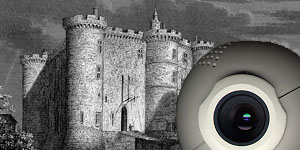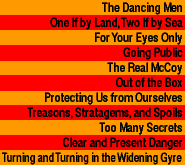


Too Many Secrets
For ye shall know the truth,
and the truth shall set you free.
[CIA Motto] The Bible, John 8:32
What is truth?Roughly five hundred years after Julius Caesar was stabbed to death by a cabal of Roman senators, the ancient Egyptians left the world a great mystery. For centuries they had written down their history using hieroglyphs, a beautiful pictorial language of signs and drawings of animals and plants. But, after long centuries of war and general disarray, knowledge of their meaning had died out. Egyptian history was now encrypted, locked in the dusty tombs and obelisks dotting the arid landscape, mute even to the modern Egyptians who moved among them, living life on the Nile as their ancestors had done for over four thousand years. The hieroglyphs weren't decrypted until some years after Napoleon's troops discovered the Rosetta stone in July of 1799.
said jesting Pilate,
and would not stay for an answer.
Francis Bacon, Essays: Of Truth
The Rosetta stone, a slab of black basalt weighing three-quarters of a ton, now stands in the Egyptian sculpture gallery of the British Museum in London. When discovered it was probably embedded in a crumbling wall in the little village of El Rashid---called Rosetta by the British---a few kilometers from the Mediterranean on the west bank of the Nile.
The stone had been inscribed about two thousand years earlier with a priestly decree to Ptolemy V, a twelve-year-old Greek boy who was the newly crowned pharaoh of Egypt. Descended from a Greek general in the army of Alexander the Great, Ptolemy V's line continued to rule Egypt for a further three hundred years---until Cleopatra VI had her dramatic and ultimately fatal run-in with Julius Caesar, Mark Antony, Augustus Caesar, and the rising power of Rome.
Almost two thousand years later, in the summer of 1814, an English physician and physicist named Thomas Young carried a copy of the mysterious Rosetta inscriptions with him on holiday. The inscriptions appeared to be in three different languages: ancient Egyptian hieroglyphs and two other languages, one of which was Greek, the language of the Macedonian dynasty that ended with Cleopatra.
Young's scientific bent led him to count frequently occurring Greek words, then to look for groups of hieroglyphs appearing roughly the same number of times. After four years of patient work, his statistical analysis gave him the beginnings of a dictionary of hieroglyphs to Greek words. Other scholars built on his work and a few years later completed the decryption.
Finally, we could again read the Rosetta Stone. Here's how it starts:
There being assembled the Chief Priests and Prophets and those who enter the inner shrine for the robing of the gods and the Fan-bearers and the Sacred Scribes and all the other priests from the temples throughout the land who have come to meet the king at Memphis for the feast of the assumption by Ptolemy the ever-living the beloved of Ptah the God Epiphanes Eucharistos.Silent for almost fourteen hundred years, the ancient Egyptians spoke again.